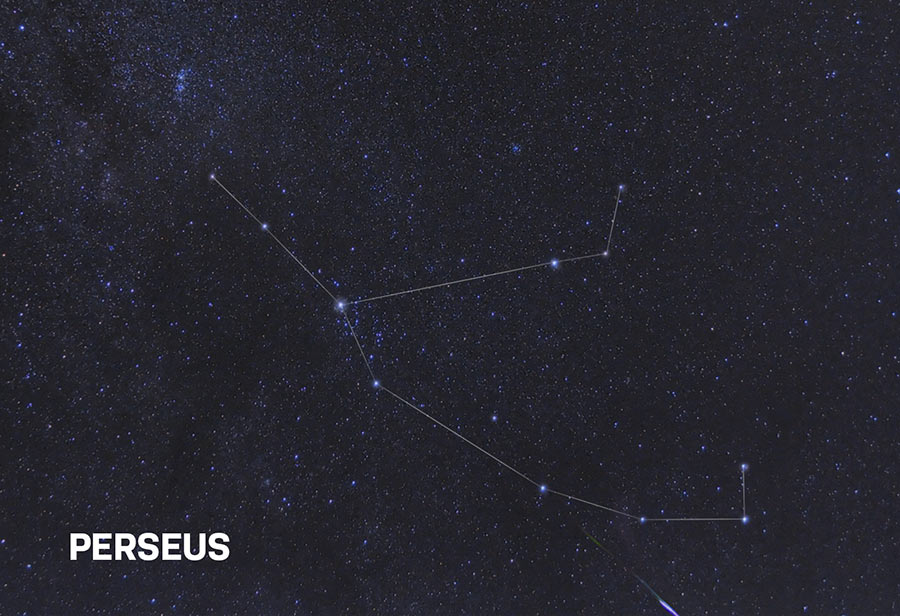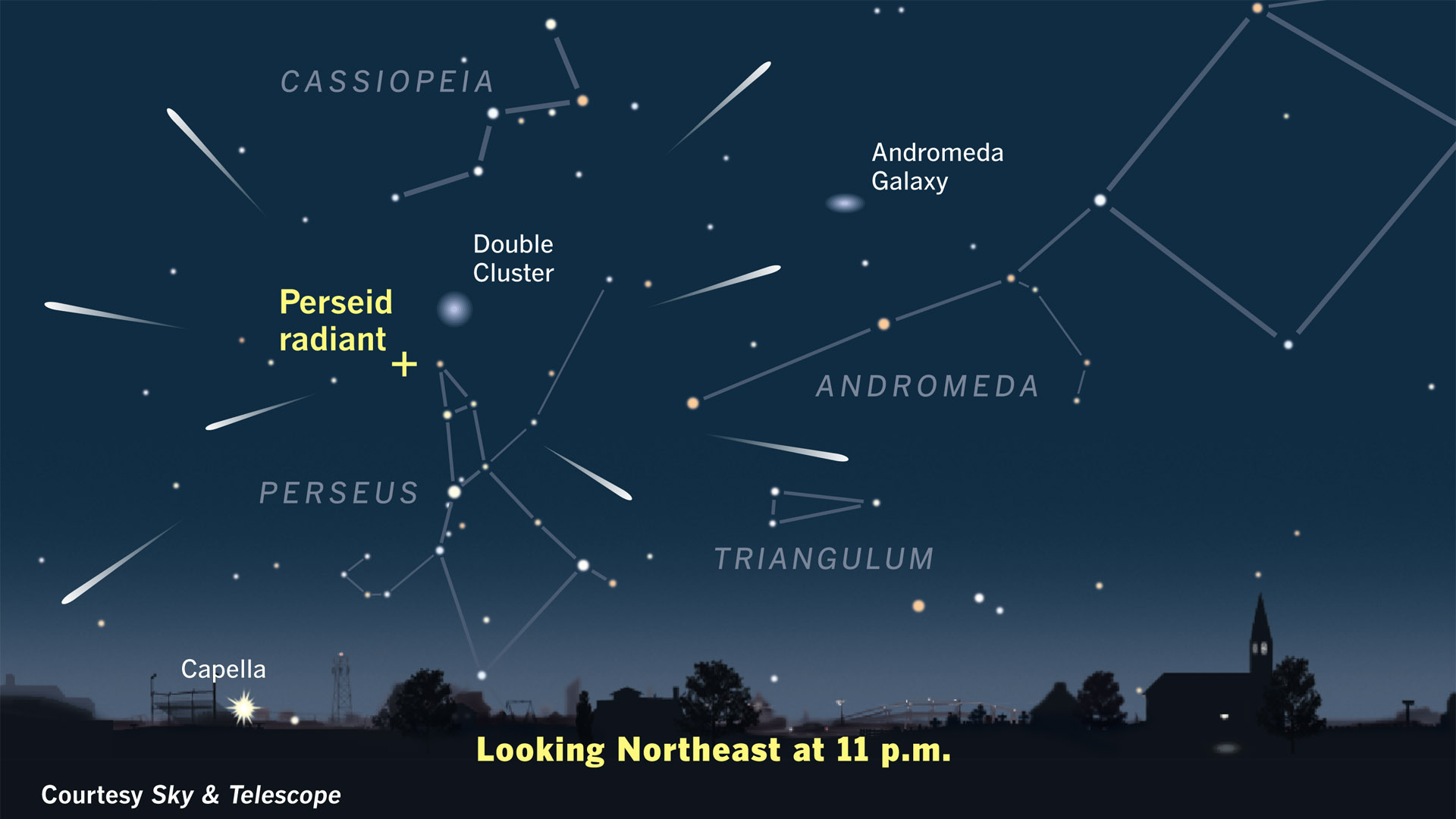Perseid Meteor Shower Shower 2024
This year, the Perseid meteor shower peaks on the night of August 11th. On this night, the first quarter moon will set around 11 p.m., which is the absolute best time to start watching the meteor shower.
You do not need a telescope or binoculars to enjoy the Perseid meteor shower. The best way to enjoy a meteor shower is with your naked eyes, looking in the direction of the constellation Perseus.
‘The Perseid rain over the Kolonica Saddle’ by Petr Horálek.
When And Where to See the Perseid Meteor Shower
For the Perseid Meteor Shower, staying up late pays off. The best time to look for ‘shooting stars’ in the sky is in the pre-dawn hours during the peak of the meteor shower.
The nights of August 11-13 are the absolute best time to look for meteors streaking across the night sky, but after midnight is best. This is because the bright first quarter moon will be present before that time and will continue to get brighter each night from the 11th.
The easiest way to find the constellation Perseus is to first locate the recognizable constellation of Cassiopeia, which looks like a big ‘W.’ You’ll find Perseus below Cassiopeia and may notice a faint fuzzy patch of stars at its northern edge (Double Cluster in Perseus).
The ‘radiant point’ of the Perseid Metoer Shower. Trevor Jones.
Remember that the constellation is not the source of the meteor shower. It is an aid to help you locate the radiant for the meteor shower, which is the point in the sky from which the meteors appear to come.
The radiant point of the Perseid Meteor Shower will rise in the middle of the night and is highest at dawn. For this reason, the best time to enjoy the meteor shower is late into the night (after midnight).
The radiant point of the Perseid Meteor Shower. Sky and Telescope.
The Best Meteor Shower of the Year
The Perseid meteor shower, also known as the Perseids, is considered the most spectacular and reliable meteor shower of the year. It produces 50 to 100 meteors per hour.
As the meteors enter Earth’s atmosphere, they burn up at high speed, leaving streaks of light and color. These are exciting to witness and are often called ‘shooting stars’
In 2024, the Perseid Meteor Shower coincides with the first quarter moon phase. This means the best time to observe will be from midnight (after the moon has set) until dawn.
It is active each year from mid-July to late August and typically peaks around the evening of August 12th through the morning of August 13th.
Perseid Meteor Shower at Dinosaur Park by Alan Dyer.
The predicted peak of the meteor shower will start on August 11 and last until August 13, so the mornings of August 11, 12, and 13 are likely your best bet to see meteors.
The warm August nights make the event extra enjoyable, as you can comfortably sit in a lawn chair and watch the whole show. The best time to catch a shooting star is after midnight when the moon sets, as this will result in a much darker sky.
To help plan your night, use an astronomy app that shows you where the constellations are. This will help you identify the radiant point in the constellation Perseus so you know where to look and point your camera.
If you are interested in photographing the Perseid Meteor Shower, the PhotoPills smartphone app is great for planning your shot. It provides a helpful overlay of the night sky from your location.
The Perseid Fireball 2018. Tang Zhengye (China).
What Causes a Meteor Shower?
Meteors are leftover particles from comets and pieces of broken asteroids. Every August, Earth passes through this stream of debris and particles left by the comet.
The source of the debris and particles for the Perseids is dust and debris from the Swift-Tuttle comet. These particles make their way into Earth’s atmosphere and burn up, producing bright streaks of light across the sky.
Also known as shooting stars, many of these meteors are quite bright and can cause a ‘wow’ reaction from onlookers.
It is interesting to note that there has been some debate as to whether this comet will eventually pass dangerously close to Earth in just over 100 years.
Further investigation into the possible catastrophe revealed that the comet’s orbit is more stable than originally thought.
Perseid Meteor Shower Viewing Tips
To enjoy the Perseids, you do not need a telescope or binoculars. The secret is to take in as much sky as possible and allow your eyes about 30 minutes to adjust to the dark.
How to view the Perseid Meteor Shower:
- Avoid light pollution: Darker skies will greatly increase the number of meteors you can see. This means getting away from the bright city lights that wash out the night sky and prevent us from seeing all but the brightest meteoroids. If you can’t travel to a dark sky site, turn off house lights and keep street lights out of view.
- Let your eyes adapt: After viewing white light, your eyes will need roughly 30-40 minutes to adjust to the darkness. This will help you view faint meteors. Avoid using any white light while viewing.
- Preserve your night vision: use a red light or headlamp to maintain your dark-adapted views
- Get comfortable: Use a zero gravity chair or blanket on the ground to avoid neck strain from looking up. This will also help you view as much sky as possible for a greater chance of viewing meteors. Though the Perseids are in August, you will want to dress according to the weather (i.e. clothing and footwear)
- Find the location: An unobstructed view of the northeastern sky and overhead is ideal. Locate the Perseus constellation; the longest trails are visible at 90° to the radiant.
A full moon can affect the number of meteors that can be seen as it washes out fainter meteors. So years when there is a crescent moon will be best for viewing the meteor shower.
The constellation Perseus is surrounded by some fantastic deep-sky objects.
Photographing the Perseid Meteor Shower
If you own a DSLR or Mirrorless camera and a tripod, you’re in luck. You have everything needed to capture beautiful photos of this celestial event.
These types of cameras (with interchangeable lenses) are great for astrophotography because they allow you to take long-exposure photos that collect more light over time.
A DSLR or Mirrorless Camera is the best way to photograph a Meteor Shower.
If you do not own a DSLR camera, you can try to photograph the event using your mobile phone, but it will be much harder to get a quality image due to their smaller image sensors and poor low-light capabilities.
The main idea behind this process is that you will leave your camera shutter open for an extended period of time for a better chance of capturing a meteor streaking across the sky.
Taking a series of long exposures over the duration of the event gives you a solid chance at capturing the action.
Photographing Perseids with a DSLR/Mirrorless Camera
- Attach your camera to a sturdy tripod and aim it roughly toward that constellation. A nice wide-field lens would really help increase your chances of getting a great shot.
- While in manual mode on your DSLR, set a slow enough shutter speed to increase your chances of a meteor streak, but not so slow that the stars begin to trail. I prefer to have pinpoint stars with streaking meteors blazing through them.
- Sit next to your tripod and continuously press the shutter button for about one hour. Alternatively, you can automate your session using a remote shutter release cable, intervalometer, or camera control through a laptop.
Automate your Imaging Session
Using photo accessories can help automate your imaging session and give you a better chance of capturing a few meteor photos. A simple intervalometer (remote shutter release cable) will allow you to program the camera to take continuous exposures for an extended period of time.
Remote Shutter Release Controller
You can also use image capture software on your computer to automate your Perseid Meteor Shower photography session.
BackyardEOS, Astro Photography Tool, and N.I.N.A can be utilized in situations like meteor showers, as they allow you to automate a series of long exposure photos. For example, you could set your camera to take 100 x 30-second shots at ISO 800.
The frames are then downloaded to your laptop with plenty of storage room. For the best results, ensure your computer has lots of hard drive storage space, and your DSLR has an AC power adapter. Running out of storage space or battery power can ruin your night in a hurry,
Creating a Composite Image
The following tutorial video does a great job explaining how to create a Perseid Meteor Shower composite image.
When shooting your series of images, it is important not to move your positioning. Choose your initial framing carefully, as you will be sticking with it for the rest of the night!
Combining your images taken during the meteor shower is rather simple, but it will make a big difference in the impact of your shot.
A glorious example of a Meteor Shower composite image. Leo Lam.
The idea is to create a single image containing every meteor you capture throughout the night. If you captured enough Perseid meteors (that came streaking out of the radiant point), you will have the elements needed to produce an image that represents the events that took place that night.
After your Imaging Session:
- Review your photos: Try to isolate the shots that contain a meteor streaking across the sky. This can be very exciting, especially if you catch a bright one! Ideally, you will have at least 3-4 shots that contain meteors, but the more the better.
- Register, stack, and process: To get a base image of your night sky, stack 10 x 30-second exposures should give you a nice smooth image containing a sky full of stars and constellations. You can process this image to pull out some fainter stars, balance the background sky, and reduce noise. This will be the underlying layer of stars for your meteor shower composite. If you were able to include an interesting foreground subject, bonus points to you!
- Blend your images: Next, take the meteor frames you selected earlier and place them on top of your base image as layers. Set these layers to “lighten” blending mode in Photoshop to reveal only the meteor, but not the noisy, unprocessed background sky. You can subtly process your meteor frames to brighten the meteor slightly but don’t overdo it.
- Create master file: Do this with all of your meteor frames to create a master file with every meteor that occurred during your session. You can then flatten the image (or create a new adjustment layer) and do some overall image edits.
Review your files to find the images with meteors for your composite image.
I hope that you have clear skies to watch one of nature’s greatest spectacles this year!
Trevor Jones










